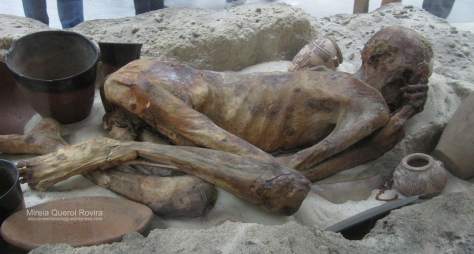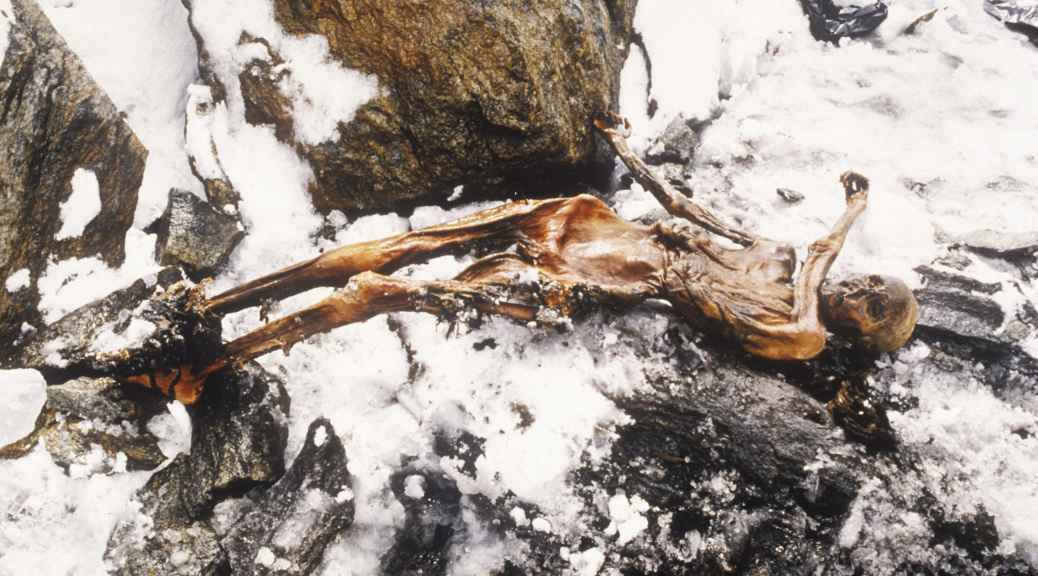Ötzi is the oldest human mummy known and one of the most studied by science. It was discovered in 1991 in the Alps and since then it has not stopped leaking information about what life was like in the Neolithic. Do you dare to find out all its secrets?
WHAT IS A MUMMY?
Mummies are preserved bodies of people and animals that still preserve their skin. The most famous are the Egyptian ones, preserved thanks to the chemical processes applied to the corpses (embalming), although many other cultures practiced mummification. But mummies can also occur naturally if the conditions are suitable to avoid decomposition, such as humid and swampy sites, in the cold of mountains and polar regions or in dry and sandy areas such as deserts. In addition to the skin, other structures that can be preserved over the millennia are nails, hair and bones and teeth.

Unlike fossils, which are millions years old, mummies do not usually exceed thousands of years, although there are fossils of dinosaurs with skin impressions or scales. If you want to know more about the processes of fossilization, we invite you to read Knowing fossils and their age. Ötzi is a sub-fossil because he is younger than 11,000 years old.
WHO WAS ÖTZI?
Ötzi, the Man of Similaun, the Man of Hauslabjoc or simply The Iceman, was discovered in the Ötz Valley (on the Austrian-Italian border of the Alps) by climbers in 1991 at 3,200 meters. Thanks to a storm in the Sahara, the dust reached the Alps and when it warmed with the sun, it melted the ice more than usual and uncovered Ötzi, who had been under the ice for more than 5,000 years. It was not until a later study that his real antiquity was discovered, since in situ seemed to be a dead climber.

Thanks to the technique Carbon 14, it was determined that Ötzi died around 3255 BC (Chalcolithic, Copper Age), which made it the oldest preserved mummy in the world. In addition to the body, more than 70 personal objects (weapons, clothing, tools…) were found, which gave more information about the life of this prehistoric man.

A MODERN HOMO SAPIENS
Throughout various posts we have talked about other species that preceded us , but Ötzi belonged to our species, Homo sapiens. The first Homo sapiens, who appeared in Africa 200,000 years ago, represented the evolutionary transition between H. heidelbergensis to the first modern humans. After more than 7 million years of evolution, H. sapiens are the only hominini survivors.

H. sapiens migrated from Africa to the rest of the continents. If you want to know about how paleoparasitology helps us to follow the migratory routes of our ancestors, do not miss this post . When Ötzi was alive, the Neanderthals had already become extinct a few thousand years ago and their sapiens ancestors had been in Europe since about 45,000 years ago.
The difference between H. sapiens and other species is a very rounded and large skull (1,000-1,400 cm 3 ) compared to the body, a flat and vertical face, small teeth a non-robust jaw, and the presence of chin, feature that does not have any of the preceding species.

If we look at the skeleton, like other recent hominins, Ötzi and we are perfectly adapted to bipedism, with a distinctive light constitution. We have long lower limbs, with the femur tilted to the knee to keep the center of gravity under the body. The pelvis is narrow and short. The spine is curved to maintain balance and distribute weight efficiently while walking, with strong lumbar vertebrae. The arms are relatively short and the hands are agile and they have excellent prehensile precision, with long and thin phalanges compared to neanderthals.

At cognitive level, what made us different from the rest of the hominin species is the symbolic thinking (representation of nature through symbols and abstract thinking), although the debate is still open since the Neanderthals had behaviors that could be considered symbolic (like decorating the body with jewelry or paintings). What is clear is that 40,000 years ago, the clearest evidence of modern behavior appeared in Europe, with the appearance of rock painting and sculpture. Technological innovation, agriculture and livestock are other of our distinctive features.
WHAT VALUABLE INFORMATION HAS REVEALED SCIENCE ABOUT ÖTZI?
Different techniques have been used to reveal information about the mummy and changing the different hypotheses over the years.

CARBON 14 AND DENTITION: AGE
Ötzi was about 46 years old when he died (life expectancy in the Copper Age was about 35 years). This data comes from the study of teeth, which are worn out, perhaps by eating grain throughout his life. The Carbon 14 test was carried out on its body and clothing: he is approximately 5,300 years old. It is estimated that he weighed about 45 kilos and he was 1.60 m tall.
COMPUTERIZED AXIAL TOMOGRAPHY (CT SCAN)
A CT Scan in the body of Ötzi brought to light that he was suffering from various oral issues, such as caries (perhaps due to the consumption of bread and oats), periodontitis (pyorrhea) and worn out teeth for using them as a tear tool. He also lost part of a molar and suffered a blow to an incisor.


He also suffered from arthritis, gallstones and he had a lump on one toe, broken nose and ribs that healed before death and had black lungs because of inhaling CO2, maybe from bonfires. More than 60 tattoos (the oldest known) were found throughout his body, consisting of small lines, crosses and points. They were made with small cuts that were then rubbered with charcoal. They do not seem decorative: it is speculated that they were part of some treatment to improve the artirtis, since they indicate the points where he was in pain.

His system also had high levels of arsenic, probably because he worked with minerals and metals.
THE LAST DINNER
An analysis of the stomach revealed that he had eaten two hours before dying. He ate ibex (wild goat), cereals and unidentified plants. They found 30 different types of pollen, so he probably died in the spring. But they also found eggs of a parasite that cause Lyme disease, which mainly affects the vascular, nervous and skeletal system.

X-RAYS: ACCIDENT OR MURDER?
First it was believed that Ötzi died due to crashing into a glacier. But radiographs revealed the presence of an arrowhead on his shoulder, so the researchers analyzed the body more closely and found several injuries in the hands, torso and a blow in the head, the cause of his death.

DNA ANALYSIS: HE SUFFERED DIVERSE DISEASES
Scientists did DNA tests in various blood samples, and they found up to 3 different types of blood. The blood of his flint knife is not from him: everything shows that he was involved in a fight with several people and was killed. His body was not found in a natural position, so two hypotheses are considered: either a partner tried to help him to extract the arrow or the enemies tried to recover it. In any case, they did not take away the advanced technology and Ötzi clothing. Why? The mystery is still open.


In 2008 the complete genome of the Ice Man was published. He was lactose intolerant, his blood was type 0, he had brown eyes, he suffered from the heart and arteries and he is related to the current inhabitants of Corsica and Sardinia. In addition, out of 3,700 DNA samples were donated by Tyrol volunteers. 19 individuals share a genetic mutation with Ötzi.
NON-HUMAN DNA IN ÖTZI
The samples of non-human DNA are usually bacteria that live in our body. A biopsy on the hip brought to light the presence of DNA from a bacterium (Treponema denticola) involved in periodontal disease, which confirmed the results of the CT Scan. They also found remnants of the bacterium Clostridium and Helicobacter pylori so Ötzi had a strong stomachache and diarrhea the day of his death. Besides, the study of Helicobacter from Ötzi has thrown new data on human migrations, the origin of European populations and the impact on our evolution.

DO YOU WANT TO SEE ÖTZI?
This discovery is so important, that they dedicated a museum almost entirely for him: the South Tyrol Museum, in Bolzano. There are exposed the impressive clothes that he wore, made with animal skins such as bears and goats, his shoes, with double layer and stuffed with straw, his tools, weapons… even the first aid kit he was carrying. And he himself, of course, preserved at -6º. Maybe one day we will hear him “talking”: they are trying to reconstruct his tone of voice from the vocal cords.

We still do not know who he was. Maybe a personality? A skilled hunter? A farmer or a stockman? A healer? We will probably never know. What is certain is that he could never imagine the attentions he would continue receiving 5,000 years after his death.


